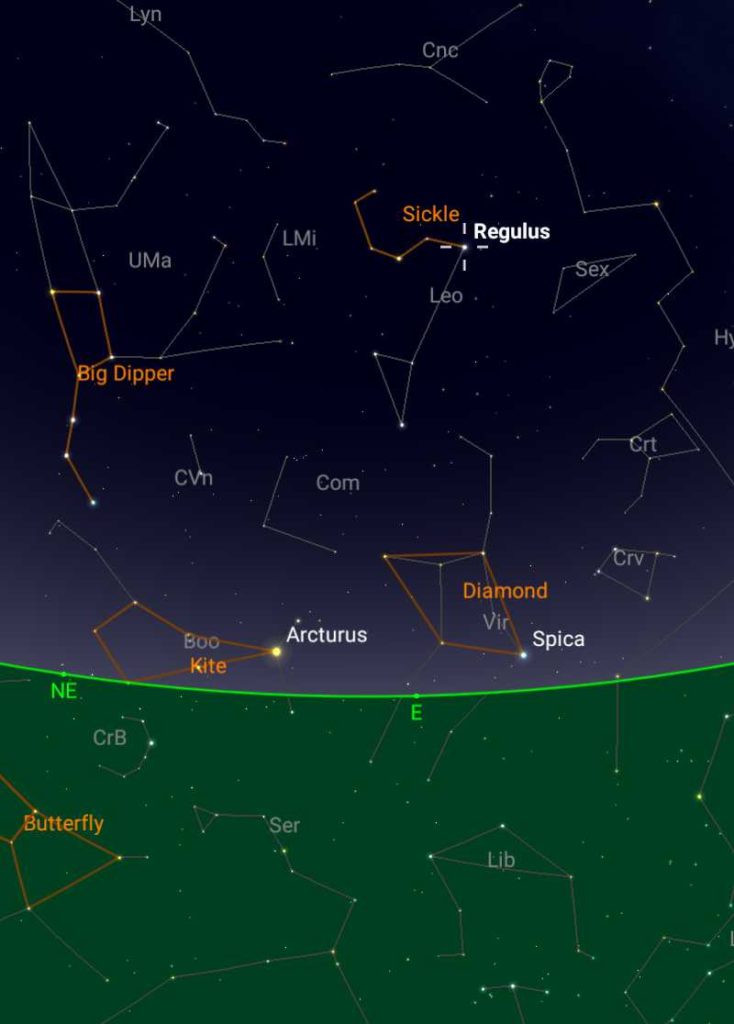Periodic updates of the astronomical happenings In La Ventana. (Looking for the Night Sky Observer’s Guide?)
November 3, 2021 —
The new moon Thursday will bring dark skies through the weekend. Find a location by 7 pm that blocks out nearby light pollution. Look for Jupiter, Saturn, and Venus lined up in the SW. Catch Venus early as it sets before 8 pm. Jupiter is in the south halfway to the zenith, with Saturn at its lower right. The summer triangle is high in the WSW, with Vega at the lower right, Deneb at the top, and Altair at the lower left.
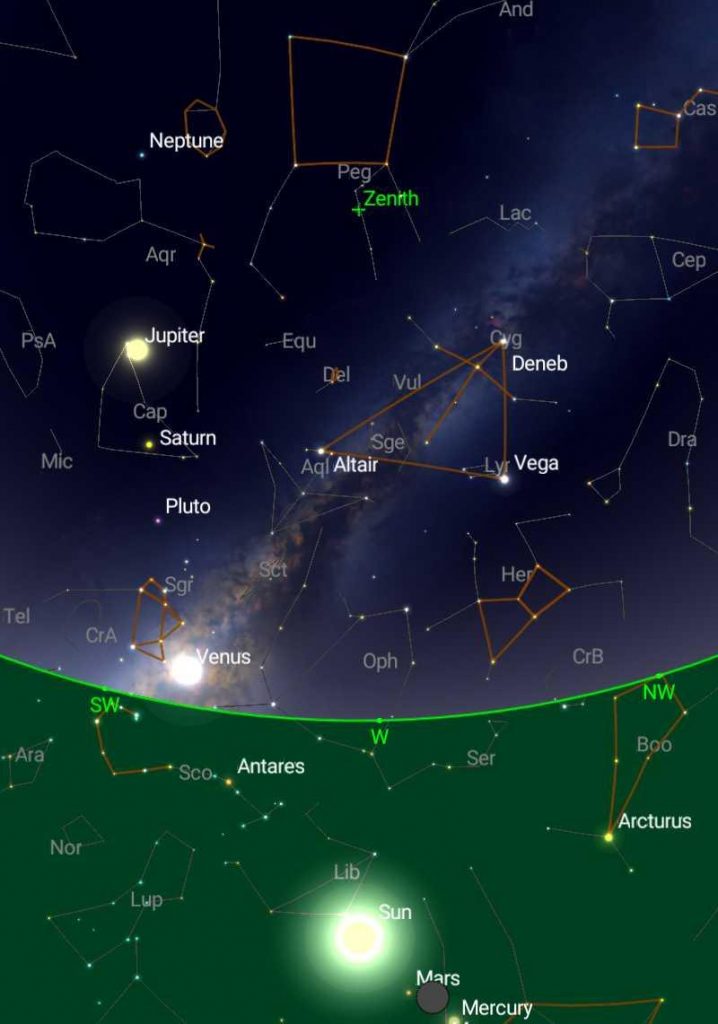
Go out by 5:30 am to see the Winter Hexagon high in the east. Sirius, the brightest star in the night sky, anchors the lower right corner just below the famous constellation of Orion the Hunter. The Big Dipper is standing over the north end of Cerralvo. Do you know how to use it to find the La Ventana’s latitude from the stars? View sky maps in the Baja Night Sky Observer’s Guide.
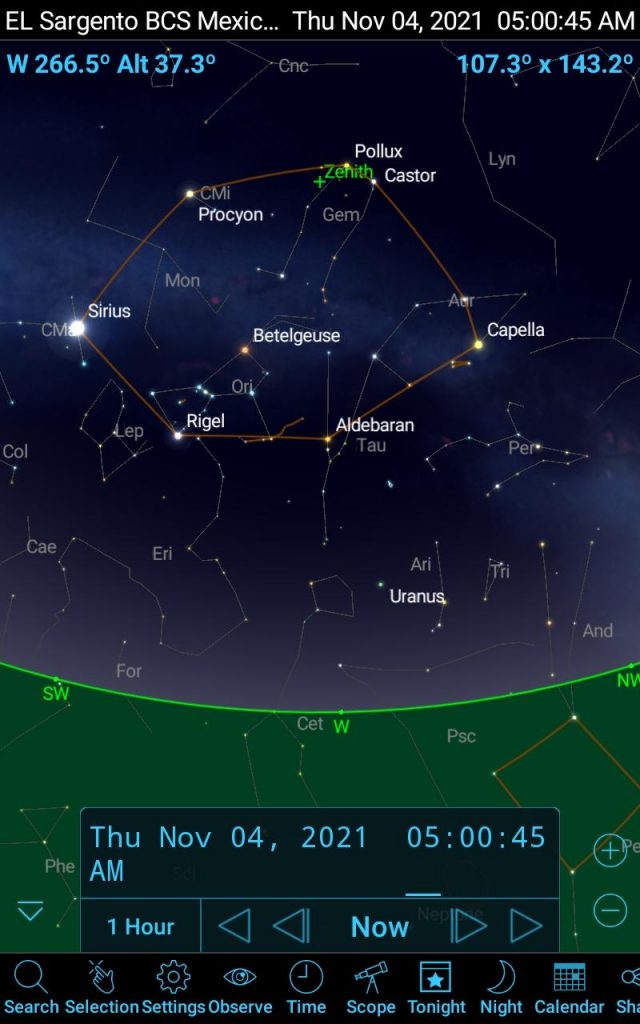
January 13-21, 2021 –Baja Night Sky for January 13-20. There are some things in the Baja Night Sky so impressive you should see them before you die: the nearest star system to Earth, the biggest, brightest, closest globular cluster orbiting outside the Milky Way, and the smallest constellation. On the next clear morning, go outside between 5:30 am and 6; the earlier, the better. If you wait until next month, you will have to get up at 3:30 am to see them.
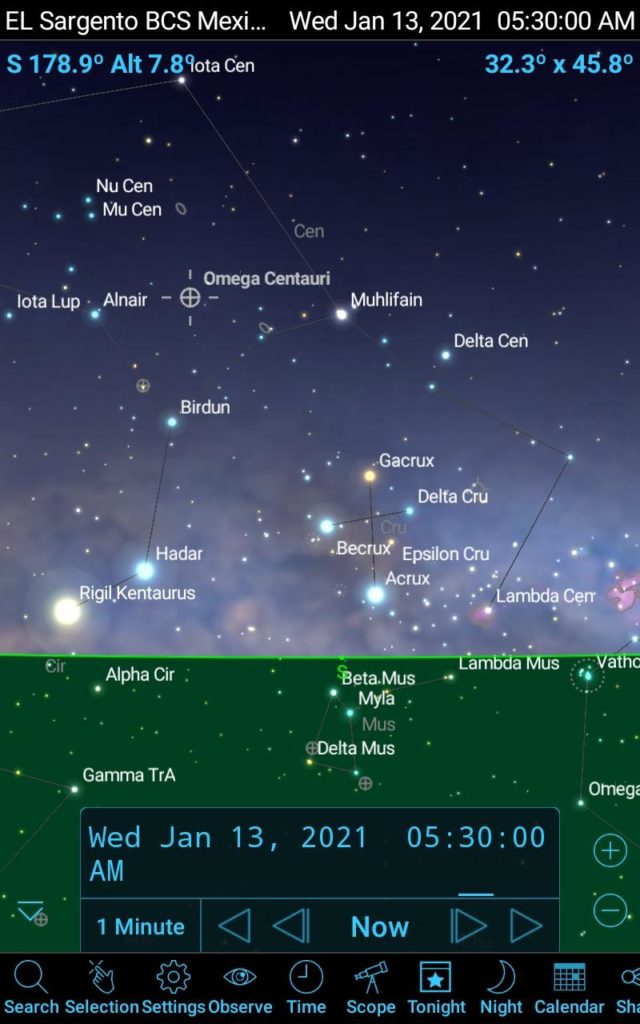
Find a location that blocks out street lights and your nearby neighbor’s lights but has a view directly south; just above the mountain tops to the south, look for a very bright star, Alpha Centauri, the third most luminous in the night sky. It’s a system of three stars. To its right and a little higher, find the star Hadar. The two stars point to the adjacent top star of the constellation known as the Southern Cross. You can’t see this constellation from back in the USA or Canada, so explore it with binoculars now.
A beautiful star cluster called the Jewel Box sits under the left crossbar star. Now draw a line through the bottom and left crossbar star and extend it about 3-4 times its length upwards. It ends in Omega Centauri, a globular cluster of 5 million or so stars 16,000 light-years away. Many people can see their moon-sized glow without binoculars. It should jump out at you using a pair. The ancients thought this was a star, but the telescopes’ invention showed a ball of millions of stars with a diameter of almost 170 light-years. Tom at BajaNightSky@gmail.com
January 6-13, 2021 — Have you heard of the star cluster called the Pleiades or Seven Sisters? Of the more than 400 faint stars in this group, most people can only see the six that form a small, hazy version of a dipper. Subaru chose these six stars for its logo. If most people only see six distinct stars in the Pleiades cluster, why is it called the Seven Sisters?
We have to do some digging for one possible answer to this question. Archeoastronomers dig up the past in the night sky. They found that Australian Aborigines also call these six stars the Seven Sisters. So did the ancient Greeks–and Native Americans. And they all have similar myths about the sisters. Some cultures even added an ending to explain what happened to the missing seventh sister. In a tale attributed to Pacific Coast indigenous populations, the Pleiades are seven sisters who, fed up with their husbands, run away together. When the men chase the wives up a hill, they leap into the sky and become the Seven Sisters of the Pleiades. The husbands follow them into the sky and become the faint Hyades cluster in Taurus. For their bad conduct, the men are doomed to forever chase their wives across the sky.
If you turn the sky clock back 100,000 years on a computer, one of the six stars separates into two distinct, visible ones, giving a total of seven. So they were farther apart 100,000 years ago before modern-day humans had left Africa. Stories about the Pleiades may have originated in Africa 100,000 or so years ago when all seven sisters were easily visible in the Pleiades. When humans left Africa, they carried those stories and their knowledge of the stars with them to the ends of the earth. If you go outdoors one evening this week and find the men chasing the sisters across the sky, you may be looking at the oldest story ever told, a story that even Pericu Indians who once lived in the Cape Region may have told their children.
I enjoy hiking in the mountains above El Sargento, where progress has not covered up the past. I have come across stone implements the Pericu Indians used hundreds, if not thousands of years ago. I always wish I knew the story about the person who made and used these stone tools. But some of their stories can be found in the night sky if you know where to look and if progress has not covered them up with outdoor lights.
We will have moonless evenings until around January 14, so take advantage of the dark sky and go outdoors between 7 and 9 pm. First, turn off your outdoor lights and ask your neighbors to turn off theirs. Look just above the eastern horizon and find Sirius, the brightest star in the night sky. It is at the lower right corner of the Winter Hexagon. Now hop up to Rigel, about 2 1/3 fists above Sirius. From Rigel, hop up and to your left 2 2/3 fists to find Aldebaran. You should see the faint, hazy six stars of the Seven Sisters between the vertical and horizontal double dashes on the star chart—about a fist above and slightly to your left of Aldebaran. Alcyone, on the map, is the name of one of the sisters. The Hyades cluster is part of Taurus, adjacent to Aldebaran. The star chart is for around 7:15 pm this week. The later you go out, the higher you will have to look in the sky.
Bookmark this page and take some time to study the information on how to become a skilled stargazer. Tom at BajaNightSky@gmail.com
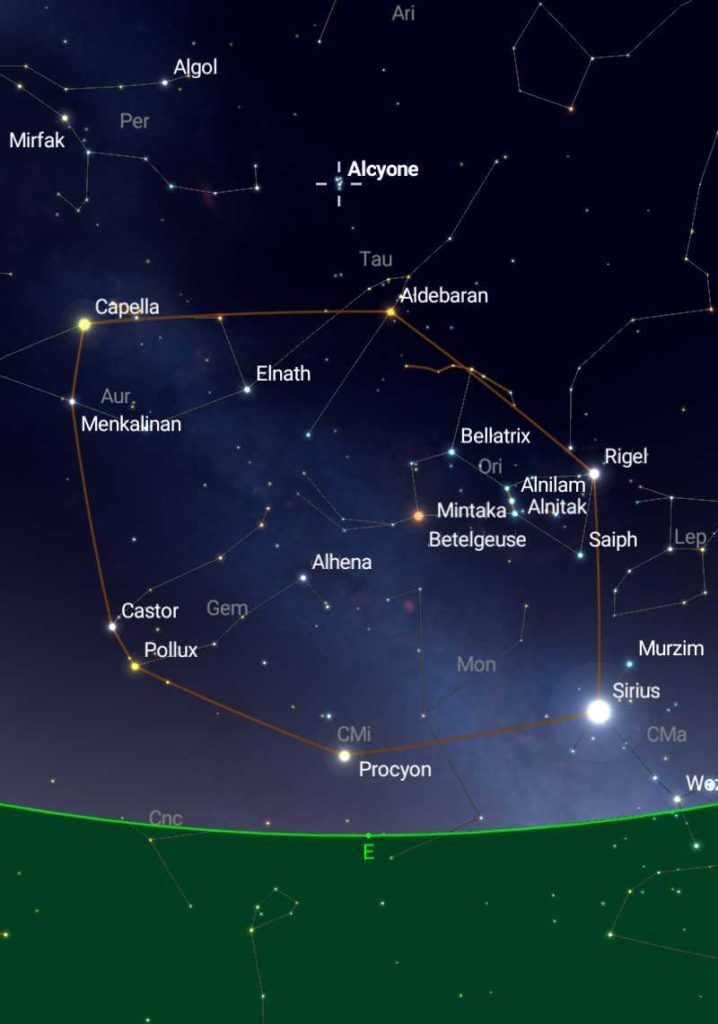
June 10, 2020 — The sun will set behind the mountains west of El Sargento and La Ventana around 8:00 pm, varying a few minutes depending on your observation location. By 9 pm the sky is fairly dark with no moon to block out fainter stars. Dusk ends around 9:20 pm, providing the darkest night skies. An hour spent from 9 to 10 pm stargazing will provide a good reward.
The Big Dipper, an asterism or star pattern that is part of the Greater Bear constellation, is high in the north. Most people know that the last two stars in its bowl point to Polaris, the North Star. There are three stars in the handle of the dipper. The middle one is actually two stars that appear close together, Mizar is the brighter, Alcor its companion. They are known as the Horse and Rider. A good test of your eyesight is to spot both without binoculars. You can use the handle to locate Arcturus, the fourth brightest star in the night sky. Follow the arc of the handle upward and on a distance a little greater than the handle to Arcturus. Vega, the fifth brightest star, is rising in the NE over Isla Cerralvo.
The real gem for tonight and the rest of the month is the constellation in the south known as the Southern Cross. Since it first appears at a reasonable hour in the evening sky in May. in Mexico it is know as La Cruz de Mayo. At 9:20 pm this week, it sits just above the mountains to the south. Not far to its left are two stars that point to the top of the cross, the brighter, Rigil Kent, is the third brightest star in the night sky, and is actually a system of three stars. One of them, Proxima Centauri, is the on about 4.3 light-years from our sun, the closest of all the stars you see in the sky. Use binoculars to scan the sky just under the left cross-bar star at about the 8 o’clock position for a sparkling cluster of colorful stars known as the Jewel Box , Use the bottom star of the cross along with the left cross-bar star to locate Omega Centauri, a globular cluster of five million-plus stars orbiting around the outside of the center of our Milky Way Galaxy. Draw a line through the two stars and extend it upward a little more than 3 times their distance apart. In dark skies with now glaring lights nearby you might spot a faint cloud the size of the moon. If not, scan with binoculars and it will jump out at you. This entire region of the sky is rich with such objects. Scroll down to the last image at the bottom of the page to see a map to help locate Omega Centauri.
Updated periodically by Tom at BajaNightSky@gmail.com
April 1, 2019 – This is International Dark Sky Week, an event to help individuals protect the wonders of the night sky. Almost 20 light pollution reports have been posted so far for the Cape Region by concerned citizens. The data shows the night sky is darker in El Sargento and La Ventana as a result of new shielded LED street lights. However, it also shows that some porch and security lights are making stargazing impossible for nearby neighbors. Read about what you can do to make you and your neighbor’s night sky darker below.
How To Work With Your Neighbor to reduce Light Trespass, Glare, and Skyglow to Bring Back Dark Night Skies.
The star Vega has magnitude (apparent brightness) of 0. Brighter stars — there are only 4 — have negative magnitudes. Dimmer stars have positive magnitudes. A magnitude 6 star is 100 times dimmer than a magnitude 1 star: the greater the magnitude the dimmer the star. For The Globe at Night light pollution reports, only one observer reported seeing stars as faint as magnitude 6 in a very dark sky. This was from a secluded east-facing porch overlooking the Sea of Cortez in El Sargento. But from a west-facing porch at the same location, only a few of the brightest stars could be seen because of a bright security light several hundred yards away. An observer in Los Barriles reported only being able to see a few of the brightest stars in any direction because of unshielded lights on the property of nearby neighbors.
These examples show that replacing old, unshielded street lights, while important for overall reduction of light pollution, is not enough to bring back the night at any given home or business location. We should all take the time to walk across the street from our homes and businesses and look back at the outdoor lighting. You should only see the light that reflects off the siding or ground. If you see a bright light, it is trespassing on your neighbor’s property and causing glare, skyglow, two forms of light pollution that do not enhance the property.
We know that nighttime light pollution has detrimental effects on energy consumption, wildlife, and human health. It also makes a property less secure, as several studies have shown. So how can we make changes to outdoor lighting that preserves nighttime security, but prevents glare, skyglow, and light trespassing onto our neighbor’s property and into their homes? The website www.darksky.org has put together the research, tools, and other resources to make this easy for everyone. Start with the two links about ¾ down the home page:
- Outdoor Lighting Can Be Dark Sky Friendly
This page provides information on the basics of good outdoor lighting.
- Frustrated With Bad Lighting
This page provides information and tools for working with neighbors to improve outdoor lighting that preserves convenience and security while eliminating or reducing light trespass, glare, and skyglow.
There is still a week left to assess night skies as your location and file a report at www.globetonight.org. Follow the instructions below.
Make a Light Pollution Report for Your Location
Continuing nightly through Friday, April 5, we have another chance to submit data about light pollution in our region. This should be interesting to see if there is an improvement since the LED street light installation in La Ventana which directs most of the light down instead of into the sky.
Here is all you have to do on any evening around 8 pm if the sky is clear enough to see stars in the constellation Leo high in the east (see map below and the relationship of Leo to the Big Dipper):
Go to the Globe at Night reporting page here: https://www.globeatnight.org/webapp/ . It should be a page record and submit your observation of the constellation Leo the Lion which will be high in the South from 8 to 10 pm. Record the following information on the webpage form. Check or choose maps for latitude 20 degrees N.
- Date and time of observation should already be recorded in section #1
- Enter the name of your location in the space above the map. Click ALLOW if asked for your location. If the map showing your location is reasonably accurate, put a check in the box below it. Otherwise, click on the map and your location, and then check the box.
- After you have been outdoors for at least 10 minutes to let your eyes adjust (don’t look towards any outdoor lights or use your smartphone), observe Leo and nearby stars. You can count the total number of distinct stars you see in Leo. It’s OK if some are outside the boundary of the constellation. I found the magnitude maps a little confusing with Leo upside down. Again, check map below for correct orientation. Click on several of the 8 small star maps under the large one until you find the one that matches most closely to what you observed. Counting stars on the map might help.
- Click on one of the Sky Condition boxes, and enter Location and Sky condition comments. You can include your initials to make it easier to check your report when it is posted on the Globe at Night world map.
- Skip this section, and
- Click on SUBMIT DATA.
You can make reports on different nights or different locations. It would be great to have reports submitted from the campground, near street lights, far from lights, Rancho Cacachilas, and other nearby ranchos and towns. Your data should appear on the Globe at Night world map within a few minutes. Click on Baja Sur and zoom in to your neighborhood. Wait a few seconds for a dot to appear, then click on it for a link to your data.
Tom at BajaNightSky@gmail.com
